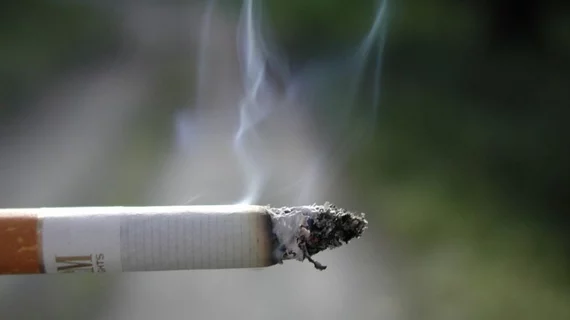Exposure to secondhand smoke in childhood increases lifetime risk of AFib
An analysis of the long-running Framingham Heart Study has revealed that exposure to secondhand smoke in childhood increases a person’s lifetime risk of atrial fibrillation.
It’s estimated that some 7% of all cases of AFib can be attributed to smoking tobacco, first author Christopher A. Groh, MD, of the University of California, San Francisco, and colleagues wrote in the Journal of the American College of Cardiology. And with a U.S. smoking rate of around 14%, the condition is expected to affect 16 million Americans by 2050.
Previous research by Groh and his team suggested exposure to cigarette smoke while in utero or as a child could increase AFib risk later in life. The authors said if those findings could be corroborated with more reliable data—their initial study relied on self-reported tobacco exposure—they could incentivize current smokers to quit and potential smokers to think twice before lighting up.
Groh et al. analyzed 2,816 people in the Framingham Offspring cohort, all of whom had at least one parent enrolled in the original Framingham Heart Study. Since Framingham participants are evaluated every two to eight years, reported their smoking status repeatedly and were monitored routinely for incident AFib, the data was more dependable.
Of the nearly 3,000 offspring with at least one parent in the original Framingham cohort, 82% were exposed to parental smoking through age 18. Every pack/day increase yielded a concomitant 18% increase in offspring AFib incidence, and parental smoking raised kids’ odds of developing the arrhythmia by 34%. Offspring smoking mediated 17% of the relationship between parental smoking and offspring AFib.
In a related JACC editorial, Alanna M. Chamberlain, PhD, MPH, acknowledged that while Groh and colleagues’ findings are telling, the study was limited by the fact that not all Framingham data could be used in the analysis. In reality, there are 5,124 offspring enrolled in the Framingham Offspring cohort, and 45% had to be excluded from analysis due to a lack of smoking data obtained during exams 1 and 2 of the Framingham Heart Study. Enrollees would have undergone those exams between 1948 and 1955, when smoking was still overwhelmingly popular and people were unaware of its harmful effects.
Half of physicians were still smoking cigarettes in the early 1950s, Chamberlain said, and even after clinical evidence implicated smoking as a cause of lung cancer, the introduction of filtered cigarettes and exhaustive marketing led to an increased prevalence of smoking until 1964.
“Although it is possible that the results of this study were not materially affected by the exclusion of offspring with missing secondhand smoke exposure, if a lack of concern about the harms of smoking contributed to behaviors leading to greater exposure to secondhand smoke in offspring excluded from the analysis, the results may have been biased toward the null, and the reported results may be conservative estimates of the true association between secondhand smoke exposure and AFib risk,” she wrote.
Chamberlain said Groh et al.’s work is a good reminder to physicians to log patient tobacco use at every visit and offer smoking cessation therapy to all current smokers.
“Although the adoption of smoke-free policies in the United States has reduced workplace exposure to secondhand smoke and made most public places smoke-free, persons may not be aware of the risk of exposure to secondhand smoke in other places, such as the home or the car,” she wrote. “Thus, clinicians should not miss an opportunity to discuss the harms of secondhand smoke with their patients, to emphasize to parents who smoke to change their smoking behaviors and reduce secondhand smoke exposure in their children, and to recommend nonsmokers to avoid exposure to secondhand smoker to reduce their cardiovascular risk.”

